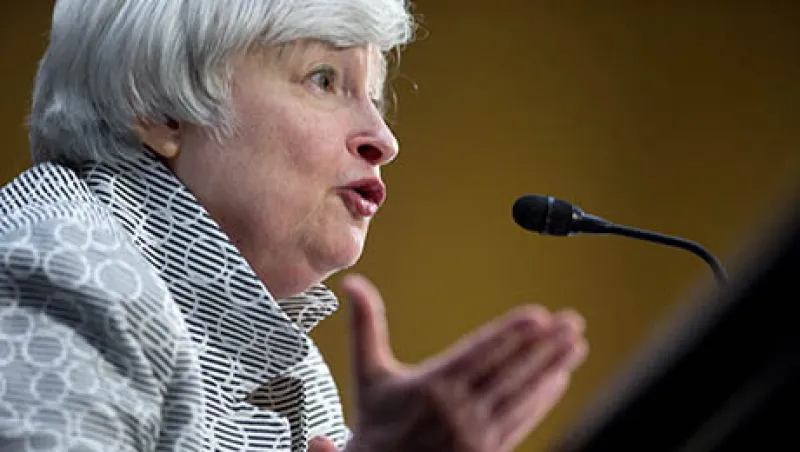Over the past year or so, bond investors have had to field a whole lot of mixed signals. The consensus view in late 2013 was that U.S. interest rates had nowhere to go but up. But now, it’s mid-September, the annual Jackson Hole confab has come and gone, and the fed funds rate is scraping zero. At its monthly meeting today, the Federal Market Open Committee announced that there is "considerable time" before interest rates can begin to normalize. Regardless of policy, the 30-year bull run on the bond market is winding down. And in the golden years of this generation of fixed-income investing, unconstrained bond funds have found their heyday.
What’s driving the interest in flexible-strategy fixed income? Since the 1980s, fixed-income markets have been under the sway of steadily falling interest rates and steadily rising leverage, says Rick Rieder, chief investment officer of fundamental fixed income and co-head of Americas fixed income at BlackRock in New York. The change in market fundamentals — particularly persistent low yields — is prompting investors to rethink the role of bonds in the performance of their overall portfolio. “It’s an interesting evolution,” he explains. “Last year you sort of saw some significant inflows into our fund and other unconstrained funds. These were largely from retail investors looking to own something that didn’t have as much interest rate risk as their other fixed-income [holdings] would.” This year, he adds, the increase in net inflows into unconstrained bond funds is coming from “a tremendous number of institutional investors — and retail as well.”
Says Jason Brady, managing director of fixed income at Thornburg Investment Management in Santa Fe, New Mexico, and portfolio manager of the firm’s $1.47 billion Thornburg Multisector Opportunistic Strategy: “Rethinking what fixed income can do in your allocation or in your general investment thought process is important for good and bad reasons.” The good reason is more options, he says. The downside is that the usual palette of fixed-income assets isn’t exactly offering, as Brady puts it, “a whole heck of a lot of return.”
In the second quarter of 2014, institutional investors increased global multisector fixed-income funds by $9.2 billion. When contrasted with an outflow of $23.1 billion during the same quarter from all fixed-income funds, according to Marietta, Georgia–based financial data firm eVestment, the surge into the smaller unconstrained bond category is all the more striking, given that the $198 billion total assets under management in these funds represents only 2.5 percent of the $7.9 trillion global fixed-income market in funds tracked by eVestment that call themselves fixed-income funds.
The BlackRock Strategic Income Opportunities Fund, which Rieder co-manages with Bob Miller, head of the multisector retail and rates team within the firm’s Americas fixed-income group, as of September 10 has more than $20 billion in assets. The fund saw $2.38 billion in net inflows during the second quarter of this year. The new allocations pushed up assets under management at the BlackRock fund by 23.5 percent over the prior quarter, according to eVestment.
Instead of a conventional benchmark, the BlackRock Strategic Income Opportunities Fund uses a target rate of return. “We’re trying to create a 4 percent return over Libor with low volatility, no matter what happens to interest rates,” says Rieder. In the two years from mid-2012 to mid-2014, the BlackRock fund returned an annualized 6.96 percent, according to eVestment — nearly 300 basis points above its target. At the same time, the Citigroup World Government Bond index (unhedged), used by some unconstrained bond funds as a benchmark, returned a paltry 0.06 percent. Cumulative returns since the BlackRock fund’s inception in February 2008 are 31.26 percent, according to eVestment. During the first half of 2014, the BlackRock fund returned 3.79 percent, slightly below its 4 percent target. The fund became unconstrained in 2010; Rieder began managing it in August of that year.
As for the Thornburg fund, in the two years from mid-2012 to mid-2014, it returned 9.44 percent annualized — crushing the performance of its benchmark, the Citigroup World Government Bond index. In the first half of 2014, Thornburg returned 5.87 percent, beating the 4.01 percent return for the Citigroup index. The timing of Thornburg’s launch of its unconstrained bond fund was partly serendipitous. During the development of the fund in 2007, says Brady, “we just said it seems like a good idea to have some flexibility, and it seems to have worked out that way.” According to eVestment, the Thornburg fund has a cumulative return of 78.9 percent since its launch on January 1, 2008.
Rieder at BlackRock expects unconstrained bond funds to remain attractive to investors who have been forced to rethink their fixed-income strategies. “When you think about where we are today and where we are going to be for the next five years, if you were to just be constrained to what is coming through the aggregate index, it just doesn’t give you enough ability to build a stable portfolio,” Rieder says.
Get more on fixed income .





